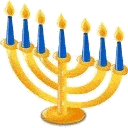The first thing I always think of when I think of MG is BEADS so using beads to make things or to learn colors and even shapes.
I have beads of all kinds (all big enough for a small child to handle and not so easy to choke on) and these are some of the things we do with them. String beads on a length of embroidery thread or a shoe lace (bigger beads). The children can make jewelry for themselves or as gifts. Have the child sort them by color to make color-patterns, by shape and by size. This reinforces the teaching already done re: colors, sizes, shapes and it improves fine motor skills as well as hand-eye coordination.
Mask
Materials: Beads, sequins, buttons, straws, paper plates, glue, tape
(optional), construction paper 1. purple 2. green 3. yellow.

First make a mask pattern from the paper plate, just to cover the eye area.
Then the children can cut or tear construction paper, sequins, beads,
buttons and feathers etc. You can use a straw to hold the mask to the eye
area. They really come out cute!
We have an international week at my preschool and we do Mardi Gras for one
day. We make jester’s hats with green, yellow and purple triangles (big) stapled
on a sentence strip, so they kind of flop over.
We also make mardi gras masks. Class cuts out the mask from white
construction paper or tag board and they deocorate with feathers and
sequins, whatever you have, staple a straw to the side for the holder. They
turn out really cute. You could also dye macaroni purple, yellow and green
and string on a necklace or use the same color pony beads. Make sure and
show the kids where France is on the globe and what a Jester looks like and
what they do.
HISTORY OF MARDI GRAS
King Cake
In European countries, the coming of the wise men bearing gifts to the
Christ Child is celebrated twelve days after Christmas. The celebration,
call Epiphany, Little Christmas, or the Twelfth Night, is a time of
exchanging gifts and feasting.
All over the world people gather for festive twelfth night celebrations.
One of the most popular customs is still the baking of the special cake in
honor of the three kings — “A King’s Cake.”
The Europeans hide a bean inside their cake and the person receiving the
bean must portray one of the kings. Latin-American people put a small
figure inside the cake representing the Christ Child. It is said that a
year of good fortune awaits the lucky person who gets the figure.
The residents of Louisiana, and the Mississippi & Alabama Gulf Coast’s like
the idea of perpetuating the celebration by having the person who received
the baby continue the festivities with another party and cake. Starting the
twelfth day after Christmas, King Cake Parties continue until the first day
of Lent, ending on Fat Tuesday, Mardi Gras Day!
King Cakes were originally a simple ring of dough with little decoration.
They are now decorated in three colors: GREEN Representing Faith; PURPLE
Representing Justice, and GOLD Representing the Voice of Power. In the
early 1970’s, Paul’s Pastry Shop, located in Picayune, Mississippi, began
filling the King Cake’s with an assortment of Fruits and Cream Cheese, then
topping them with the brightly colored Mardi Gras sugars and sliced almonds
… thus beginning the new tradition of the Mardi Gras King Cake. Our
customers not only have the choice of the traditional cinnamon King Cake,
but also an exotic deliciously filled King Cake with your choice of up to
four flavors in the same cake.
Thousands of King Cakes are consumed at parties every year in Louisiana and
on the Mississippi Gulf Coast. A cultural gumbo of European tradition,
pagan celebration and religious doctrine spiced with more than a dash of
local flavor, today’s Mardi Gras has evolved as an American phenomenon
unique to the Gulf Coast region. Here at Paul’s Pastry Shop in Picayune, MS
we wish to continue the Mardi Gras tradition making a quality product for
our customers to enjoy.
Mardi Gras
What’s all the fuss over the plastic beads? I heard that one year at Mardi
Gras. What’s the fuss!!!!!!! Well, they are the currency of Mardi Gras.
Without them you are just plain broke.
For starters beads are what brings smiles to peoples faces when they get
some tossed their way. Second, they are what provokes the women, and men to
bare all. Why, I have seen people even get into fights over the cheap beads.
But, the most joyful thing about beads is the excitement that is created
when you are tossing them out into the crowd, or when a woman comes up and
says “what will it take to get those beads”. Also, some of the best beads
for Mardi Gras 2000 will be Glow in the Dark beads, Alien beads, and
Millenium beads. Also, watch out though for the rare Krewe of Elvis beads.
ARTS AND CRAFTS
How to Design a Mardi Gras Miniature Float
Supplies:
1 Shoebox
Green tissue paper or tinfoil
scotch tape
1 Jester Doll
Aluminum Doubloons
Mardi Gras Beads
Glitter
Open box and cover top of box and bottom of box with paper. Decorate with
your personal style
You can also use:
Food items like cookies and candy, ribbons, beads, GI Joe, Weebil Peoples,
Barbie, etc., and make any theme you want.
Mardi Gras is for all and personal expression is encouraged. Whatever the
decorator wants..the decorator creates.
ACTIVITIES
1) Make mini parade floats out of shoe boxes.
2) Bake a king cake and hide a small, plastic baby doll inside (or several
so there won’t be any hurt feelings). King cakes taste similar to cinnamon
rolls with icing, so we substitute these quite often for the children. Once
the icing is on top, let the children sprinkle with purple, green, and gold
sugar crystals.
3) Make Mardi Gras masks out of tag board and let the children decorate
with beads, feathers, glitter…the more gaudy, the better.
4) Have a “throw-me-something mister” party. Line the kids up and just
start tossing trinkets while playing Cajun, Zydeco, or Jazz music. True
Mardi Gras parades do not throw candy at all. Suggestions: Beads,
inexpensive cups, small toys (like what is found in gumball machines), etc.
Just be careful to watch for small parts!
5) Have a purple, green, and gold theme day.
COOKING
King Cake
Traditional New Orleans Recipe
Ingredients
1/2 cup warm water (110 to 115 degrees)
2 packages active dry yeast
5 egg yolks
1/2 cup plus 1 teaspoon sugar
3 1/2 – 4 1/2 cups flour unsifted
1 teaspoon nutmeg
2 teaspoons salt
1 teaspoon lemon zest
1/2 cup warm milk
1 stick butter cut into slices and softened, plus 2 tablespoons more softened butter
1 egg slightly beaten with 1 tablespoon milk
1 teaspoon cinnamon
1 1″ plastic baby doll
Directions
Pour the warm water into a small shallow bowl, and sprinkle yeast and 2
teaspoons sugar into it. Allow the yeast and sugar to rest for three
minutes then mix thoroughly. Set bowl in a warm place for ten minutes, or
until yeast bubbles up and mixture almost doubles in volume. Combine 3 1/2
cups of flour, remaining sugar, nutmeg and salt, and sift into a large
mixing bowl.
Stir in lemon zest. Separate center of mixture to form a hole
and pour in yeast mixture and milk. Add egg yolks and, using a wooden
spoon, slowly combine dry ingredients into the yeast/milk mixture. When
mixture is smooth, beat in 8 tablespoons butter (1 tablespoon at a time)
and continue to beat 2 minutes, or until dough can be formed into a
medium-soft ball. Place ball of dough on a lightly floured surface and
knead like bread. While kneading, sprinkle up to 1 cup more of flour (1
tablespoon at a time) over the dough. When dough is no longer sticky, knead
10 minutes more until shiny and elastic. Using a pastry brush, coat the
inside of a large bowl evenly with one tablespoon softened butter. Place
dough ball in the bowl and rotate until the entire surface is buttered.
Cover bowl with a moderately thick kitchen towel and place in a draft-free
spot for about 1 1/2 hours, or until the dough doubles in volume. Using a
pastry brush, coat a large baking sheet with one tablespoon of butter and
set aside. Remove dough from bowl and place on lightly floured surface.
Using your fist, punch dough down forcefully. Sprinkle cinnamon over the
top, pat and shake dough into a cylinder. Twist dough to form a curled
cylinder and loop cylinder onto the buttered baking sheet. Pinch the ends
together to complete the circle. Cover dough with towel and set it in
draft-free spot for 45 minutes, or until the circle of dough doubles in
volume. Pre-heat oven to 375 degrees.
Brush top and sides of cake with egg wash and bake on middle rack of oven
for 25 to 35 minutes until golden brown. Place cake on wire rack to cool.
If desired, you can hide the plastic baby in the cake at this time.
Colored sugars
Green, purple, & yellow icing paste 12 tablespoons sugar
Squeeze a dot of green paste in palm of hand. Sprinkle 2 tablespoons sugar
over the paste and rub together quickly. Place this mixture on wax paper
and wash hands to remove color. Repeat process for other 2 colors. Place
aside.
Icing
3 cups confectioners sugar 1/4 cup lemon juice
3 – 6 tablespoons water
Combine sugar, lemon juice and 3 tablespoons water until smooth. If icing
is too stiff, add more water until spreadable. Spread icing over top of
cake. Immediately sprinkle the colored sugars in individual rows consisting
of about 2 rows of green, purple and yellow.
Cake is served in 2″ – 3″ pieces.





